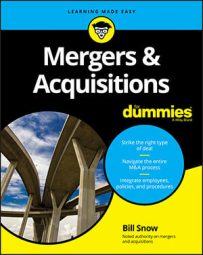The number one M&A negotiating tactic to steer clear of is bullying. For some crazy reason, negotiating novices tend to think negotiating is about imposing their will on the other side with a take-no-prisoners approach.
Bullying and cajoling don’t work. Bullying simply gets in the way of getting a deal done. Someone experienced at negotiating M&A transactions either sidesteps the bullying, ignores it, or calls the bully out.
Bullying puts the bully in a tough spot. It either kills the deal or yields nothing, thus rendering the bully an impotent blowhard. It also creates a situation where the recipient of the aggression may someday return the favor.
The only time you may be able to get away with a bullying approach is if the other side is completely desperate to do a deal. But even then, the belligerent approach may well backfire on you some day when you need a favor from the other side or if you need the other side to stay involved in the business.
But bullying is only the tip of the iceberg in terms of potential negotiating pitfalls. Here are some other tactics to avoid while negotiating:
Drawing a line in the sand: This approach is a favorite of the belligerent bullying novices. Drawing a line in the sand merely places the line-drawer in a corner. If, and invariably when, the drawer needs to close a deal, the line-in-the-sand approach actually backfires; if the line-drawer is willing to cede a point formerly ensconced behind the line, what else will she give up?
Resorting to “take it or leave it”: This tactic is the bratty cousin to the line-in-the-sand approach. Anyone who utters this line better be willing to have the other side leave it. If the other side simply walks away and the person who gave the ultimatum actually wants to do a deal, that person has simply exposed her position as weak and tenuous.
Yelling: Yelling is the path of choice for the impatient and creatively bankrupt. Keep your temper under control. If calm, dispassionate logic and reason fail to win the day, histrionics do no better. And what’s worse, yelling may simply poison the well and prevent future discussions.
If discussions do devolve into frustration, illogic, and shouting, simply stop talking. Tell the other side that you want to table that particular point and revisit it down the line. Halting discussions for a short period of time allows the other side to reflect on its point of view and revisit discussions with a more reasonable approach.
Bogging down in minutiae: Getting sidetracked by insignificant points and worthless detail at the expense of hammering out the main issues needlessly slows a negotiation and may kill your deal. Prioritize the issues and suggest revisiting the point later.
Overselling: When the other person says “yes,” stop talking and take the offer. After you and the other side find agreement, stop selling your point. Say thanks and move on to the next order of business.
Devolving into personal attacks: Separate the business issues from the personal issues. Don’t allow a business negotiation to spiral into a personal insult slugfest. Bite that tongue, stick to the business issues, and refrain from making the discussions personal.
Be wary of lawyers, usually young and relatively inexperienced lawyers, out to prove to their superiors that they’re tough, hard-nosed lawyers. Their focus seems to be to prove they won’t yield on a single point and therefore will beat the other side into submitting to every demand. This take-it-or-leave-it approach is a major impediment to getting a deal done because it usually results in the other side leaving.

